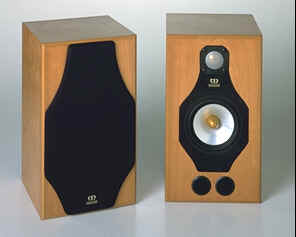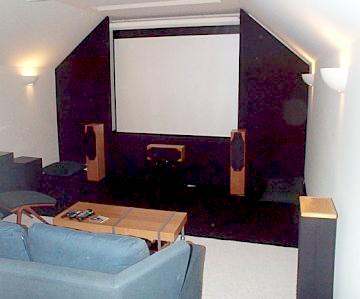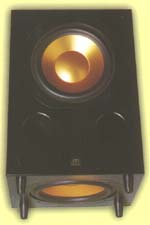Product Review - Monitor Audio
Silver Cinema Series Home Theater Speakers - April, 2000
Evan Upchurch
![]()
|
|
Monitor Audio Silver 9i Speakers Bass Reflex, One Rear Port MFR: 30 Hz - 25 kHz ± 3 dB Sensitivity: 90 dB/w/m Impedance: 6 Ohms Nominal Power Handling: 150 Watts RMS, 300 Watts Peak Size (HWD): 39" x 7¾" x 10¾" MSRP: $1,900/pair Available Finishes: Natural Cherry (shown), Rose Mahogany, and Black Oak
|
| Monitor Audio USA, P.O. Box 1355, Buffalo, New York 14205-1355; Phone: 905-428-2800; E-Mail [email protected]; Web http://www.monitoraudio.com |
Introduction
The home theater aficionado has many masters. Video must be clear without visible scan lines or softness introduced by overlapping scan lines. Furniture must be comfortable, but not so comfortable that your friends never leave your theater. And finally, the sound must recreate the cinematic experience as accurately as possible. Hmmm . . . there must be something I forgot. Oh yeah, you probably want to listen to music now and again.
It had really been drummed into me up until now. "If one wants a home theater, one must sacrifice the music listening experience." Unless you count yourself amongst the ranks of vinyl elitists, this is no longer an issue with a wide assortment of modern loudspeakers. This is especially true with Monitor Audio's well heeled family. As you will see below, I felt the speakers under review performed well in both capacities. This is not to say that they are the perfect solution, but I would entreat you to continue for more details.
Here are the pieces I reviewed:
Silver 9i (shown above)
- 3-way system
- 2 x 6.5" Bass/ midrange driver with C-CAM (Coated Ceramic Aluminum Magnesium) Cone
- 1" NeFeb Gold dome tweeter
- Ported design 3-way system
Silver 4i
|

|
Silver Centre 12i
|

|
ASW 210
|
|
We received the speakers, and as far as I can tell, we spent approximately 100 years breaking them in. Perhaps I am exaggerating, but when you listen to the break-in CD's random frequency hopping/white noise for hours on end, it tends to wear on you. A better estimate would be 30 days. Why did we break them in for so long? Because they feature metal cones. Very rigid ceramic aluminum magnesium cones. This is the perennial pursuit of speaker designers. They want to find the material that moves easily when a signal is applied, without any undesired flexing or resonance. Monitor Audio has perfected the use of magnesium in the metal cones, which helps to reduce ringing (metal cones are like bells). Many metal cone designs are just aluminum, which has more ringing. Magnesium makes the cones very difficult to shape during manufacturing, as they tend to crack. It is sort of like trying to roll out some pie dough that is very dry. Tough to do, but Monitor Audio has figured out how to succeed at it.
Without proper break-in, these speakers sound harsh and poorly defined. If you purchase these speakers, make sure to give yourself enough break-in time before inviting your other home theater buff friends for a demo.
After we ended the break-in period, I used the Avia Test disc to calibrate sound levels and inter-speaker distance.
Appearance and Workmanship
These speakers are simply beautiful. It seems almost a shame to leave the grills on them given the unique appearance afforded by the metal drivers. Take a look at the photos above and examine the cones. They are gorgeous, AND they have a wonderful personality (every person's dream).
It is even more of a shame to use the cherry wood speakers in a home theater where speakers might be heard but barely seen. I have found myself looking at them during slow sequences in movies and admiring them. But alas, I can only look for a little while longer before they have to return home to their Monitor mothership.
The 9i allows bi-wiring with the dual set of gold-plated binding posts. There is also space in the back to fill the base of the speakers with sand to enhance their bass response. I did not do this since I felt the sub addressed this issue sufficiently.
Audition time, places everyone!
My current home system consists of Mirage fronts and center, Definitive Technology BP8 rears, and a Velodyne FSR-18 sub.
Audio: The Monitor speakers are amazingly detailed. I noticed new elements in music that I am very familiar with. I listened to a number of tracks off of "Bjork's Post" CD and three tracks on the Chesky Records' "Ultimate Demonstration Disc" (a great purchase for auditioning speakers). In Bjork's "It's Oh So Quiet" track, we have a number of excellent speaker-testing sounds: a brassy orchestra, lively bass, with sections of spoken word . The track allows me to examine the finesse of speakers as well as their ability to kick me in the gut. Her words were clear and the orchestra detailed and dimensional. However, this detail was accompanied by a sharpness that wasn't necessarily negative, just noticeable. These speakers are especially good at revealing the limitations of modern digital recordings. Sibilants on both test diskc were pronounced, and I found myself wondering if I should find an equalizer to roll off some of the high end.
With my Sunfire amp driving them, the sound was rather cold. Let me emphasize that they executed the musical signal with amazing detail, but I wanted a little more warmth. When I switched to the new Theta Dreadnaught, the speakers softened a bit. So, the Monitors seem to be a bit selective on components that they play well with.
Home Theater: These speakers are amazingly good for home theater. When I transitioned from stereo music to my favorite movie segments, the Monotirs really began to shine. The five speakers in this package form a perfect family. The sub is well integrated into the sound and capabilities of the other speakers. It added impact without drawing attention. I attribute this to the speakers as well as having properly calibrated the system using our sound pressure level meter.
I listened to my favorite clips from particularly diagnostic movies. In "The Fifth Element", the Diva's voice is airy and transparent, yet little definition is lost when the sequence transitions to fighting and shooting. It actually gave me a sense of the space the orchestra was sitting in. Of course it didn't seem to correspond to anything on the screen, but as we all know, movie sound is created as a Frankenstein's monster of disparate pieces assembled far away from the original sound environment.
In "Apollo 13", the launch sequence showed the Monitor Audio's impact while also reproducing the faint rattle of loose bolts inside the ship's cockpit. When I first listened to quality home theater speakers, along with high performance surround processing and amplification, this was the first thing that jumped out at me. The launch sequence captures the awesome power of a Saturn V rocket with the anxiety that some number of components may not have been secured properly, and the Monitors deftly handled everything I threw at them.
Conclusion
If you watch movies 70% of the time and want speakers that handle audio with authority for the remaining 30%, you must audition these speakers. I would cautiously recommend them for audio because of their dependence on certain amplifiers to gain an appropriate amount of softness and warmth.
Test Components
|
Amplifier |
Sunfire Cinema Grand and Theta Dreadnaught |
|
CD Player |
Marantz CD-63SE |
| HTPC | Toshiba DVD-ROM
Transport Sound Blaster Live Sound Card with SP/DIF |
|
Surround Processor |
Lexicon DC-2 |
|
Test Room (9'x13'x15') |
 |
| Music Auditioned | "Bjork's Post" and Chesky Record's "The Ultimate Demonstration Disc" |
| Movies Auditioned | "The Fifth Element" and "Apollo 13" |
- Evan Upchurch -
and . . .
A Short Follow-up
Having originally received the Silver Series from Monitor Audio, I did the break-in for Evan. I used the Sheffield labs Test & Burn-in CD (Track 8). I played it in repeat mode for 7 days, 24 hours a day. I am beginning to believe that this CD is not as good as playing real music for long periods of time. I am still using the Full Metal Theater reviewed back in June of 1998, and they also took a long time to break-in.
I agree with Evan about mating the Monitor Audio speakers with just the right power amplifier. I too find the Sunfire to be a bit cold or shrill with the Monitor Audios. And while the Theta amplifier does add needed warmth, it comes with an overall loss of bottom-end. I have found that the Parasound amplifiers designed by John Curl to be a better match all around. I use the HCA-1206 with the Full Metal Theater but I also really like their new HCA-1205a (review coming shortly).
Another important factor is the surround processor or preamp that is being used with the Monitor Audio speakers. Evan used the Lexicon DC-2, which really excels on movies, but is less ideal for music listening. I used the Meridian 861 which is as good as you can get for music and is just as capable with movies. I even tried the old Meridian 565, and both processors ended up producing a warmer sound with the Silver 9i speakers than did the Lexicon DC-2.
Evan and I also tried using the Meridian 508.24 CD player mated with a Korean tube preamplifier and the Theta Dreadnaught power amplifier. Neither of us had ever heard this preamp before. (The same holds true for the Dreadnaught, and this was also the first time the mighty power amplifier had been plugged-in.) There was absolutely no bottom-end at all with the tube preamp. It is like someone had completely filtered out the bass. At the same time, the top-end was very cold sounding. Needless to say, the preamp was disconnected, and then the Dreadnaught began a much needed break-in period.
Doing a direct comparison of the two sets of Monitor speakers, we found there are some interesting differences. First, the new ASW 210 sub is MUCH better than the old MAS 1 subwoofer. I feel it better integrates (more seamless) with the main speakers and is capable of cleanly reproducing the lower frequencies. Unlike many subs that just offer you the choice of 00 or 1800 for phase, the ASW is variable from 00 - 1800. I found this to allow better integration with the 9i and 4i.
I found that the Silver 9is could convey more gut-shaking bass than the 703PCM towers can. In fact, in using the Silver 9i, I can't get over just how low they can go. The track "Tiger" from the Paula Cole CD “This Fire” is my standard for true deep bass. I have had to prove to my friends that there was no subwoofer assisting these unimposing speakers (9is).
While the 9is have no problem besting the 703s in the bass department, the 703s are a bit warmer on the top-end. Their sibilance is not as pronounced, so you could say they are more forgiving to our current digital technology. I believe this really has to do with break-in, and I am willing to bet that with another 100 hours on the Silver series, the 703s would be just a faint memory in my mind.
I opted for the bipolor/dipolar type rear surround speakers for the full metal theater as they are easier to place in a home theater environment when trying to cover a large area with many viewers. For the Silver series I chose to go with direct firing rear surround speakers and so picked the Silver 4i. With multi-channel music finally becoming a reality, I feel that direct radiating speakers are the way to go. The Silver 4i are compact and would actually make a great 2-channel music system when paired with either the ASW 110 or 210 subwoofers. (This is where the variable phase control really comes in handy.)
I much prefer the Silver 12i center channel over the smaller CC700 center channel from the Full Metal Theater. Center channels do most of the work with movies, and the 12i really benefits from its larger drivers and size. The 12i also looks simply stunning in Cherry while the CC700 looks like a black box (that's because it is a black box). There were a couple of occasions where the 12i did draw attention to itself with a boxy sound, but this was more in the beginning.
- Stacey Spears
![]()
© Copyright 2000 Secrets of Home
Theater & High Fidelity
Return to Table of Contents for this Issue.



